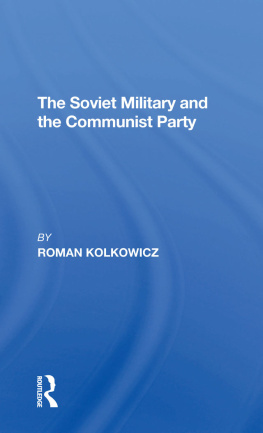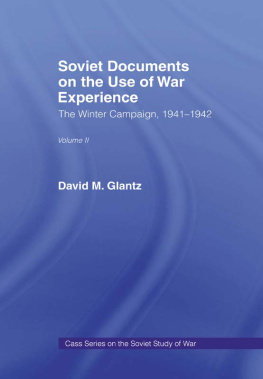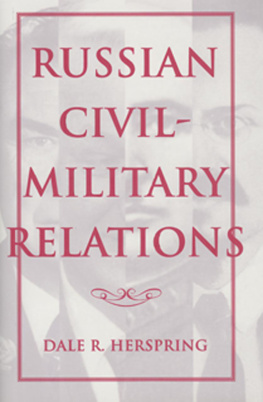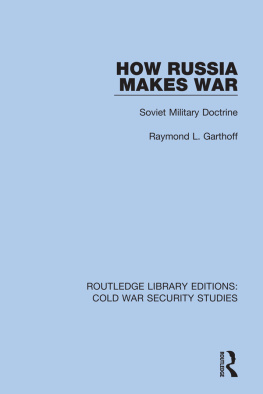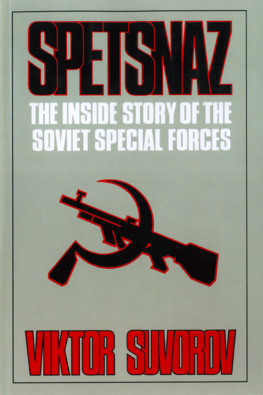First published 1988 by Westview Press
Published 2019 by Routledge
52 Vanderbilt Avenue, New York, NY 10017
2 Park Square, Milton Park, Abingdon, Oxon OX14 4RN
Routledge is an imprint of the Taylor & Francis Group, an informa business
Copyright 1988 by Taylor & Francis
All rights reserved. No part of this book may be reprinted or reproduced or utilised in any form or by any electronic, mechanical, or other means, now known or hereafter invented, including photocopying and recording, or in any information storage or retrieval system, without permission in writing from the publishers.
Notice:
Product or corporate names may be trademarks or registered trademarks, and are used only for identification and explanation without intent to infringe.
Library of Congress Cataloging-in-Publication Data
Scott, Harriet Fast.
Soviet military doctrine : continuity, formulation, and
dissemination / Harriet Fast Scott, William F. Scott.
p. cm.
Bibliography: p.
Includes indexes.
1. Soviet UnionMilitary policy. 2. CommunismSoviet Union.
3. Communist strategy. I. Scott, William Fontaine, 1919-
II.Title.
UA770.S355 1988
355.033547dc19
88-11102
CIP
ISBN 13: 978-0-367-28824-2 (hbk)
The purpose of this book is to document from basic Soviet sources the development of Soviet military doctrine and its impact upon the Soviet Armed Forces.
Soviet military doctrine is defined as the military policy of the Communist Party. In one way or another, this policy affects the lives of all of usas a possible threat to free institutions and political processes as well as to our economic life and well-being. Generally we approach Soviet military policy in terms of military balances and weapons: comparisons in the number of men under arms, the speed of aircraft of the Soviet bloc versus that of NATO aircraft, the number of ballistic missiles and their throw-weights. Studying such balances is of critical importance in defining, to some degree, existing forces. But it is only through a deep and thorough study of the military policy of the Communist Party, which translates directly into military doctrine, that we can obtain the background that might aid in negotiating with the Soviets on arms control matters or in making decisions that will enable those nations outside of the Soviet bloc to deter future Kremlin military moves.
Since there is no commonly held ideology in the United States, there is a tendency to assume that Marxist-Leninist ideology, from which Soviet military doctrine stems, is of no consequence to the Kremlin leadership. In like manner, since we do not have a military doctrine in the Soviet sense, we generally consider Soviet military doctrine to be unimportant or overlook it entirely.
The various aspects of Soviet military doctrine are found in many Soviet books, from those for young children to those for teenagers getting ready for compulsory military service, and philosophical treatises for officers, generals, and admirals. This should not be surprising, because the purpose of military doctrine is to prepare the entire nation for the possibility of future war.
Soviet military theorists frequently paraphrase V. I. Lenin: To determine the direction in which a known process will develop further, it is necessary to detect in it the remnants of the past, the basis of the present, and the embryo of the future. In order to understand what the future might hold for a certain concept, one must start with an examination of how the concept arose and what actual conditions gave birth to it. Similarly, to understand Soviet military doctrine and its possible changes at any specified time, we must start with the early days of the Soviet state when the concept of a military doctrine was first formulated and trace the development of that doctrine up to the present. We also should investigate where, how, and by whom the doctrine is formulated and how it is disseminated.
In the first part of this book, we will examine the content of Soviet military doctrine. We will begin our examination with the earliest formulations made after the 1917 October Revolution and trace the emerging doctrine through the noisy debates of the 1920s and through the long silence of the Stalin years to its reemergence in 1960. The military doctrine of Khrushchev will be contrasted and compared with the military doctrine of Brezhnev. We will then look closely at Soviet military doctrine as it passed through the short regimes of Andropov and Chernenko and describe its development in the Gorbachev era.
It is difficult to examine military doctrine without also looking at a very closely connected subject, the laws of war. After giving a short analysis of that subject, we will turn to the question of how military doctrine is formulated, what role the Communist Party and the government play, and what input is made by the military and by the Soviet military-industrial complex. Once military doctrine is formulated, the Party must disseminate selected elements of the doctrine both to the military and to the population at large. The Party also makes known certain portions of doctrine to potential enemies. In some periods the doctrine is made to appear threatening; at other times, as in the late 1980s, to appear benign.
We recognize the danger of concluding a work about Soviet military doctrine when significant changes may be taking place in the Soviet Union. But at some point research must stop and conclusions must be drawn. Whatever may be the outcome of the perestroika undertaken by General Secretary Mikhail S. Gorbachev in the latter half of the 1980s, we hope other analysts will build on the research we have completed.
Assistance from the Earhart Foundation has made it possible to devote time to research. John H. Morse, as in the past, continued to provide encouragement. The pioneering work of John Sloan and Allan Rehm in investigating the laws of war was of major assistance. One of our sons, Christopher Scott, was most helpful in final editing and in rechecking sources.
Harriet Fast ScottWilliam F. Scott


